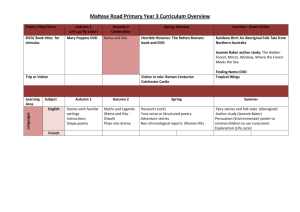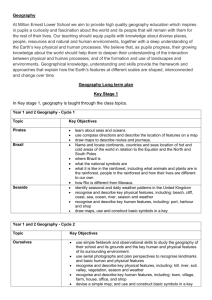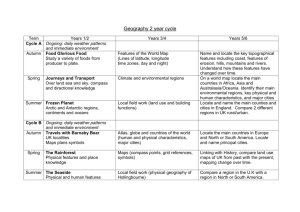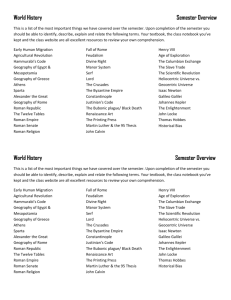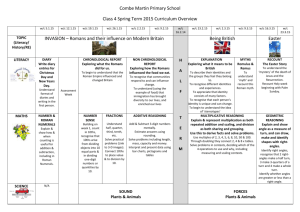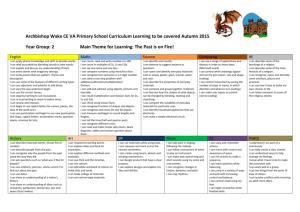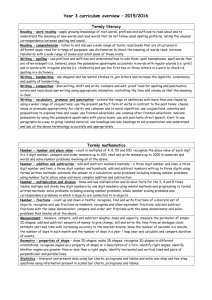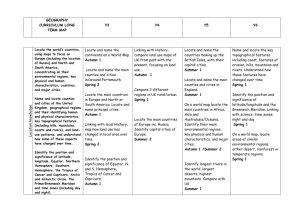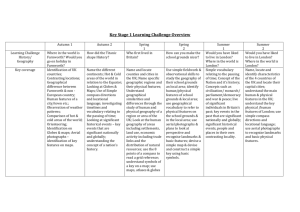Year 4 Skills coverage - Thorpedene Primary School
advertisement
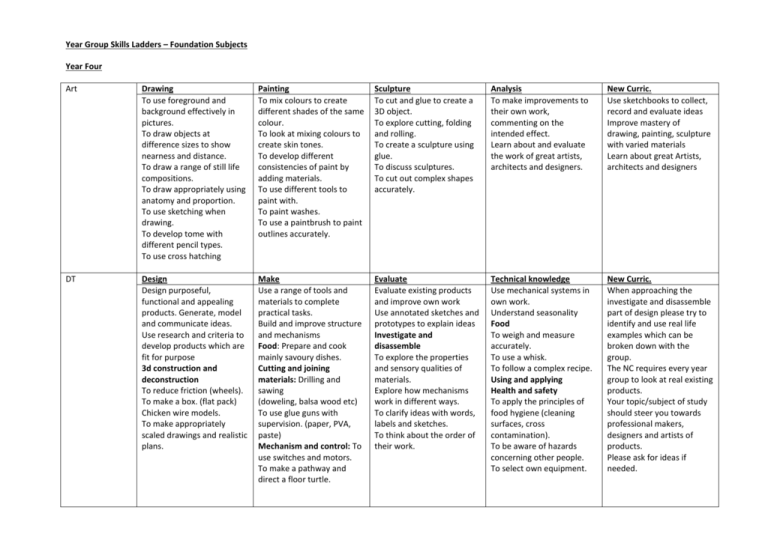
Year Group Skills Ladders – Foundation Subjects Year Four Art Drawing To use foreground and background effectively in pictures. To draw objects at difference sizes to show nearness and distance. To draw a range of still life compositions. To draw appropriately using anatomy and proportion. To use sketching when drawing. To develop tome with different pencil types. To use cross hatching Painting To mix colours to create different shades of the same colour. To look at mixing colours to create skin tones. To develop different consistencies of paint by adding materials. To use different tools to paint with. To paint washes. To use a paintbrush to paint outlines accurately. Sculpture To cut and glue to create a 3D object. To explore cutting, folding and rolling. To create a sculpture using glue. To discuss sculptures. To cut out complex shapes accurately. Analysis To make improvements to their own work, commenting on the intended effect. Learn about and evaluate the work of great artists, architects and designers. New Curric. Use sketchbooks to collect, record and evaluate ideas Improve mastery of drawing, painting, sculpture with varied materials Learn about great Artists, architects and designers DT Design Design purposeful, functional and appealing products. Generate, model and communicate ideas. Use research and criteria to develop products which are fit for purpose 3d construction and deconstruction To reduce friction (wheels). To make a box. (flat pack) Chicken wire models. To make appropriately scaled drawings and realistic plans. Make Use a range of tools and materials to complete practical tasks. Build and improve structure and mechanisms Food: Prepare and cook mainly savoury dishes. Cutting and joining materials: Drilling and sawing (doweling, balsa wood etc) To use glue guns with supervision. (paper, PVA, paste) Mechanism and control: To use switches and motors. To make a pathway and direct a floor turtle. Evaluate Evaluate existing products and improve own work Use annotated sketches and prototypes to explain ideas Investigate and disassemble To explore the properties and sensory qualities of materials. Explore how mechanisms work in different ways. To clarify ideas with words, labels and sketches. To think about the order of their work. Technical knowledge Use mechanical systems in own work. Understand seasonality Food To weigh and measure accurately. To use a whisk. To follow a complex recipe. Using and applying Health and safety To apply the principles of food hygiene (cleaning surfaces, cross contamination). To be aware of hazards concerning other people. To select own equipment. New Curric. When approaching the investigate and disassemble part of design please try to identify and use real life examples which can be broken down with the group. The NC requires every year group to look at real existing products. Your topic/subject of study should steer you towards professional makers, designers and artists of products. Please ask for ideas if needed. History Geography Know and sequence key events of the times studied. Use relevant terms and period tables. Identify and explain the differences between our own lives and the everyday lives of people in the past. Examine causes and effects of great events and the impact on different people. Compare life in early and late times studied. Compare an aspect of life with the same aspect in another period. Study different aspects of different people – differences between men & women, rich & poor. Begin to evaluate the usefulness of different sources. Compare accounts of events from different sources – fact or fiction. Use text books and historical knowledge. Independently choose relevant material to build up a picture of a past event. Begin to identify primary and secondary resources. Select relevant sections of information from within a text. Organise work into a structure, including dates and historical terms. Locational Knowledge On a world map, locate areas of similar environmental regions, either desert, rainforest or temperate regions. Locate the main counties and cities in a chosen area of Name and locate the UK. Progression Locate the world’s countries, using maps to focus on Europe (including the location of Russia) and North and South America, concentrating on their environmental regions, key physical and human characteristics, countries, and major cities. Place Knowledge Progression Name the main counties and Understand cities in a geographical similarities and chosen area of the UK. differences Name areas of through the similar study of environmental human and regions, either physical desert, geography of a rainforest or region of the temperate regions. United counties and cities of the United Kingdom, geographical regions and their identifying human and physical characteristics, key Kingdom, a region in a European country, and a region within British History: Roman Empire and impact on Britain. Julius Ceasar, attempted invasion. Roman Empire and successful invasion. Roman Empire and successful invasion. British Resistance – Boudicca. Broader History Study: Early Ancient Civilisatons – Ancient Sumer, Indus Valley, Ancient Egypt or Shang Dynasty of Ancient China. Roman conquest and rule, including: Caesar, Augustus, and Claudius Britain as part of the Roman Empire the decline and fall of the Western Roman Empire Human & Physical Geography Progression Describe and Describe and understand key understand key aspects of: aspects of: Physical Physical geography, geography, including: including: climate zones, biomes and climate zones, biomes and vegetation belts, vegetation belts rivers, mountains, (link to work on volcanoes and earthquakes, and Rainforest)Types the water cycle. of settlements in modern Britain: Human villages, towns, geography, cities. including: types of settlement and land use, economic activity Skills & Fieldwork Progression Use maps, Use maps, atlases, atlases, globes globes and and digital/computer digital/computer mapping to locate mapping countries and describe features (Google Earth) studied. to locate countries and Use the eight points describe of a compass, four and six-figure grid features studied references, symbols Learn the eight and key (including points of a the use of Ordnance compass, fourSurvey maps) to build their figure grid knowledge of the references.Use United Kingdom and fieldwork to the wider world. observe, measure and Use fieldwork to topographical features (including hills, mountains, coasts and rivers), and land-use patterns; and understand how some of these aspects have changed over time. North or South America. including trade links, and the distribution of natural resources including energy, food, minerals and water. Identify the position and significance of latitude, longitude, Equator, Northern Hemisphere, Southern Hemisphere, the Tropics of Cancer and Capricorn, Arctic and Antarctic Circle, the Prime/Greenwich Meridian and time zones PSHE MFL Skills to cover Able to reflect on their mistakes and make amends. Begin to make responsible choices and consider consequences. Reflect and evaluate their own experiences and set personal goals. Research, develop and discuss topical issues, problems and events. Research and understand differences between rights and responsibilities. Recognise why rules are needed in society. Extend strategies to cope with risky situations. Be able to keep themselves safe in both the actual and virtual world. Reflect on sources of inspiration in others’ lives. Empathise with the lives of people living in other places and times, and people with different values, experiences and customs. Be able to identify strategies to respond to negative behaviour constructively and ask for help To read fluently To write imaginatively To read and understand the main points of short written texts. Read short texts independently. Use a dictionary to look up new words. Write short sentences using familiar expressions. Express personal experiences and responses. Write short phrases from memory (introductions, greetings) observe, measure and record the human and physical features in the local area using a range of methods, including sketch maps, plans and graphs, and digital technologies. record the human and physical features in the local area using a range of methods, including sketch maps, plans and graphs, and digital technologies. New curriculum requirements Reflection and discussion are important. Where necessary circle time can be used. Dilemmas and challenges to provoke questions and thoughts. To speak confidently Understand the main points from spoken passages. Exact pronunciation. Ask other to repeat where necessary. Take part in a discussion. To understand the culture of the countries language is from Identify countries which speak the language. Show an awareness of the customs of countries that speak the language. (songs and festivals) Show awareness of social RE (See Medium Term plan for ideas/details) What is worship? Understand what is meant by worship -Explain why religious people come together to worship. -Reflect on their responses to their own experiences of worship in and outside school, Journeys/Christmas Examine and reflect on the concept of pilgrimage -Investigate and explain the significance of pilgrimage in some of the major world religions. -View the Christmas story from the perspective of those who went on special journeys. -Make links with their own experience of journeys and the symbolic journey of life. Special Holy Books Learn why some books have special significance in religions -Know the names of some sacred books and how they should be treated. -Identify some key stories and teachings from the sacred books they have learned about. -Explain why a particular book or words are important to them. Demonstrate a growing vocabulary conventions when speaking. (colours, numbers to 30, pets, conversation language). Right & Wrong Thinking about God RE – on - Sea Learn what is meant Explore the concept of Explore the question by ‘moral values’ God ’who are we and -Identify some key -Learn relevant subject where do we belong?’ religious rules for living vocabulary. -Use a range of and evaluate their -Discuss and compare research and inquiry impact on the lives of different beliefs about skills to investigate the believers. the nature and significance of religion -Reflect on ideas of existence of God. in the local community. right and wrong and -Reflect on their own -Identify how religious their own and others’ views and beliefs. families and responses to them. communities practice their faith and the contribution this makes to local life. -Reflect on ways of celebrating the diversity in the local community by working together to plan an assembly in which all can participate. Year Group Skills Ladders – SCIENCE Science Topics – statutory units to be covered in each year group During years 3 and 4, pupils should be taught to use the following practical scientific methods, processes and skills through the teaching of the programme of study content: asking relevant questions and using different types of scientific enquiries to answer them setting up simple practical enquiries, comparative and fair tests making systematic and careful observations and, where appropriate, taking accurate measurements using standard units, using a range of equipment, including thermometers and data loggers gathering, recording, classifying and presenting data in a variety of ways to help in answering questions recording findings using simple scientific language, drawings, labelled diagrams, keys, bar charts, and tables reporting on findings from enquiries, including oral and written explanations, displays or presentations of results and conclusions using results to draw simple conclusions, make predictions for new values, suggest improvements and raise further questions identifying differences, similarities or changes related to simple scientific ideas and processes using straightforward scientific evidence to answer questions or to support their findings. Units to be covered in year Year 4 Living things & habitats Animals, including humans States of Matter Sound Electricity recognise that living things can be grouped in a variety of ways explore and use classification keys to help group, identify and name a variety of living things in their local and wider environment recognise that environments can change and that this can sometimes pose dangers to living things. describe the simple functions of the basic parts of the digestive system in humans identify the different types of teeth in humans and their simple functions construct and interpret a variety of food chains, identifying producers, predators and prey. compare and group materials together, according to whether they are solids, liquids or gases observe that some materials change state when they are heated or cooled, and measure or research the temperature at which this happens in degrees Celsius (°C) identify the part played by evaporation and condensation in the water cycle and associate the rate of evaporation with temperature. identify how sounds are made, associating some of them with something vibrating recognise that vibrations from sounds travel through a medium to the ear find patterns between the pitch of a sound and features of the object that produced it find patterns between the volume of a sound and the strength of the vibrations that produced it recognise that sounds get fainter as the distance from the sound source increases. identify common appliances that run on electricity construct a simple series electrical circuit, identify and name basic parts, including cells, wires, bulbs, switches & buzzers identify whether or not a lamp will light in a simple series circuit, based on whether or not the lamp is part of a complete loop with a battery recognise that a switch opens and closes a circuit and associate this with whether or not a lamp lights in a simple circuit recognise some common conductors and insulators, and associate metals with being good conductors.

